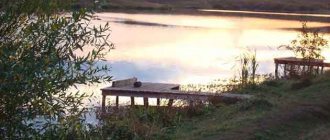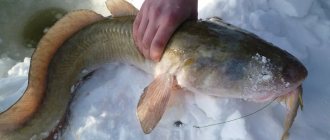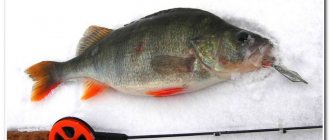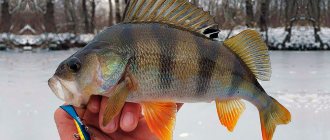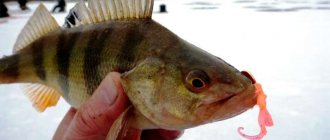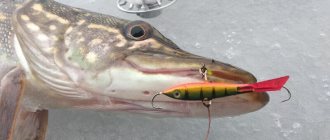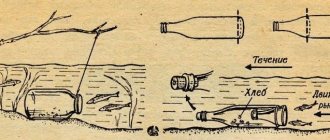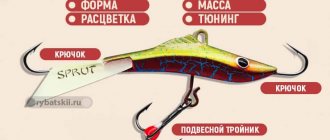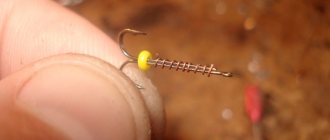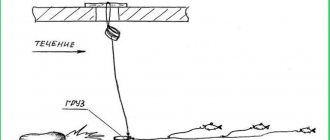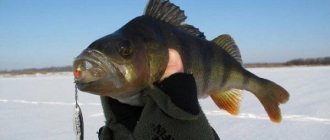Perch can be caught throughout the year, but it is winter perch fishing that is considered the most exciting and exciting, especially on the first and last ice. During these periods, perch is especially active, and its principle of staying in schools makes the fish one of the main objects of hunting. In this article we will thoroughly understand how to catch perch in winter using all available gear.
How to catch perch in winter
The effectiveness of winter fishing for perch is largely determined by the following tactics:
- Study the bottom topography properly and all its features. Early in the morning and in the evening, the perch occupies the edges; at high pressure, it moves closer to the surface
- Holes are made not 1-2, but a much larger number, at a distance of 5-8 meters from each other.
- You need to throw bait into each hole
- They start fishing from the hole that was fed first, after which they move on to the rest
- If you can't catch a perch, try moving from the shore closer to the middle, exploring all layers of water
Fishing places
Most often, perch fishing in winter takes place at shallow depths - up to 2-3 meters. It is best to look for a predator in the following areas:
- Sandbanks
- Channel and bank edges
- Boundaries of remnant aquatic vegetation and clean water
- Bottom irregularities
- Near trees and stones submerged in water
Depending on the type of reservoir, the perch’s parking spots may vary.
Small rivers and lakes
Here it is much easier to look for perch; the fisherman should focus primarily on the coastline, look for steep banks, landslides and slopes. Moving along the coastline, they examine all promising areas - uneven areas, snags, edges, deep-water areas under bush branches.
Large bodies of water
It is more difficult to find perch here due to the larger water area. But you can count on catching trophy specimens. There is no point in moving around the entire body of water in search of fish; it is better to immediately identify possible places for its parking. These can be underwater ridges, dumps, areas near pits.
Where to look for perch on the lake in winter
First of all, when you get to a small body of water, you need to apply the skills of searching for fish hiding under the ice. Experience and knowledge of the nature of the reservoir will help you here. Almost all ponds created on small rivers and streams have similar characteristics. First of all, these are riverbed areas that have significant depths, and the deepest places in the ponds are located in front of the dam (dam).
The larger the perch, the more picky it is about the places where it lives. Such places should be convenient for hunting and provide him with good shelter. Perch loves places with varied topography, local holes, snags, large underwater rocks, channel edges and other shelters. An important element of attractive places for perch is the presence of aquatic vegetation. With a high probability of perch in the pond, you can find it near reed thickets or near the walls of thick reeds. You definitely need to drill a hole or two there. But if there are thickets of hornwort, you should not look for perch there.
However, you shouldn’t hope too much that you will be successful in the places listed above. After all, other fishermen could already be fishing there in front of you, and the most active perches have already become their prey. And the remaining specimens, out of caution, dispersed to other places. And getting them accustomed will become more difficult. Often, an angler, having caught several dozen perch at one point, will see only rare bites there the next time, or the perch will not want to bite there at all. Then only moving to another place can save the situation. However, this does not always help on a small pond. The bite may stop for several days.
On an unfamiliar pond, the tactic for finding perch is to frequently move around the water area. The holes are tested in several runs, changing the frequency of play on each run. In this case, you should tap the bait on the bottom, and then move to the next hole. Some fishermen, after catching the first specimen, gut it to reveal the contents of the stomach. This way, you can determine what the perch eat in a given pond and select the right bait or artificial bait.
The most important thing when drilling holes is to do it as carefully as possible without fussing, otherwise you can scare away the prey and it won’t be long before the fish calms down and returns to where the hole is located. If the hole works well and the perch is active there, then it is advisable to drill a few more around it at a distance of 4 or 5 m.
Tackle
Gear for catching perch in winter is as follows:
- Thin and flexible fishing rod
- Inertia-free reel, the simplest option is enough
- Mono line, the average size of which, depending on the bait, ranges from 0.08-0.18 mm
- Medium hardness nod made of lavsan or polycarbonate
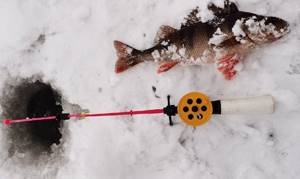
What does perch eat?
What does perch eat? It is unpretentious in food, practically omnivorous and insatiable. Eats almost everything that moves. Let's take a closer look at his daily diet.
Eats various small animals up to 6 cm in length, plankton:
- eats larvae of various insects;
- zooplankton;
- small leeches;
- shellfish;
- water worms;
- Gammarus crustaceans;
- small frogs;
- eats one-year-old whitefish, especially loves bottom-dwelling and inactive fish: gobies, minnows, minnows;
- caviar;
- eats its own young.
Meals depending on the time of year
- In early spring it eats little and is rather passive. Activity increases even with slight warming of the water. It begins to intensively hunt and eat, and prepare for spawning. After spawning in April, the real gluttony begins.
- In the first half of summer it rarely eats, but in the second half and under favorable weather conditions the activity of the predator increases threefold. And the perch eats everything indiscriminately. By the end of summer, it begins to replenish its fat reserves and scour in search of food, without interruption.
- In autumn, the predator continues to eat even more briskly, especially when the weather is stable. The bite can last 5-6 hours in a row.
- At the beginning of winter, activity decreases and gradually subsides; the predator lies on the bottom until spring.
Diet depending on age
In the initial stage of development, perch eats only planktonic invertebrates. But having reached a size of 25-60 ml, the young animals begin to eat various small things: gobies, bleaks, sticklebacks, minnows, crucian carp.
Good to know! They can also eat their smaller brothers, up to 15 mm in size. They greedily swallow their prey and often grab the next victim while the tail of the previous one is still sticking out of their mouth.
Fishing methods
Perch is caught in winter using many baits, which explains the variety of methods used to catch it.
Lure fishing
There are a huge number of winter spinners for catching perch, so when choosing, follow these tips:
- The best materials for spinners are copper, tin, brass.
- Color is not so important; perch generally prefers dark-colored baits
- At the beginning of winter, perch go better with small spoons, gradually increasing their size
For winter fishing of perch with a spinner, a regular winter fishing rod, 50 cm long, equipped with a nod, is used. The length of the whip is about 30 cm, several passage rings. Fishing line with a diameter of 0.15-0.18 mm.
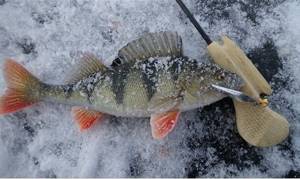
Lure fishing involves examining a large number of holes. The standard game with the bait is when it sinks into the hole to the bottom, followed by a short rise and smooth swings.
During periods of increased activity of the perch, the amplitude of the strokes reaches 20-30 cm, at the extreme points there are pauses of several seconds. If there are no bites within 3-5 minutes of such a game, change the hole.
Fishing with a jig
Catching perch in winter with a jig is one of the most popular methods. To do this, use various baits - bloodworms, burdock moth larva, maggot.
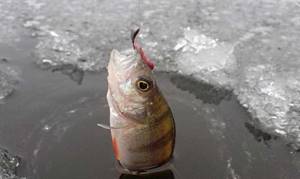
Jigs used when fishing with bait must meet the following requirements:
- Drop-shaped or spherical shape
- Size approximately 3-4 mm - for fishing at medium depths and large - for catching trophy perch at great depths
- Bait material – lead, tin, tungsten
- The color may be different; yellow and red jigs are often used, additionally attaching bright beads
- Jig weight - depending on the bait
For fishing with a jig, a light winter fishing rod equipped with a nod is suitable. The flexibility of the nod is selected depending on the jig, under the weight of which it should not bend more than 30 degrees.
The fishing rod is equipped with a thin, transparent fishing line with a diameter of 0.1-0.12 mm. The use of colored fishing lines is unacceptable.
The tactics for fishing with a jig are as follows:
- The bait sinks to the bottom, after which it rises up 15-20 cm and sinks to the bottom again
- The ascent becomes greater, they try to change the speed of ascent and descent
- The jig is lowered and raised with sharp jerks with pauses at short distances from the bottom
- The jig is lowered to the bottom and several taps are made, from which a cloud of turbidity rises from the bottom, attracting fish
The speed of play with the bait, the amplitude - all this needs to be selected, they largely depend on the degree of activity of the perch, the characteristics of the reservoir, and the weather.
Reelless fishing
You can successfully catch perch with a baitless jig. These are baits that, in their shape, resemble various small aquatic inhabitants that serve as usual food for fish. There is no need for a nozzle.
The most suitable reelless baits for perch include the following:
- Uralka
- Ant
- Banana
- Butterfly
- Nymph
Sizes and colors are selected as fishing progresses, but it is worth noting that silver and dark baits are often more catchy.
The fishing rod for baitless fishing is used almost the same, only the nod is set to a longer length - up to 10-15 cm. Thin, transparent fishing line, with a diameter of about 0.1 mm.
Fishing tactics are practically the same as with a regular jig - standard ascents and descents, with or without jerks.
Fishing with a reel requires more concentration and constant movement of the bait. Therefore, it is better for beginners to start practicing with a regular jig.
Catching a devil
The Chertik is essentially also a baitless jig, with the difference that it has a triple hook. For perch, a devil about 20 mm long, elongated, teardrop-shaped, is suitable.
The fishing rod used is the same, but with a medium-hard nod. The fishing line is thicker - 0.1-0.14 mm, since this bait involves catching large perch.
Fishing tactics involve descents and sharp ascents, after which the bait is allowed to smoothly sink to the bottom. After a short pause, everything repeats. You can tap the bait on the bottom, raising the mud, and move it slightly, imitating the movements of an insect.
The devil is a universal bait used in different bodies of water and in any weather.
Fishing on a balance beam
A balancer is a bait that looks like a fry in its appearance. It is caught more often in the middle layers, it is located horizontally. In its play, the balancer resembles a small fish. Equipped with two hooks.

The balancer for perch is selected according to the following parameters:
- Length 4-5 cm, allows you to catch both small and trophy perch
- There are no special restrictions on shape, although there is an opinion that wide-shaped baits work better.
- The color is preferably natural, characteristic of fish fry, which are the main food for perch
To catch perch in winter on a balancer, use a shorter winter fishing rod of medium hardness, equipped with a reel. Mono line, diameter 0.16-0.18 mm.
The fishing tactics using a balance beam are usually like this:
- The balancer sinks to the bottom
- Then it rises slightly, after which a sharp swing is made so that the bait flies up 30-35 cm.
- The rod returns to its previous position
Fishing on the bulldozer
This bait is well suited for winter perch fishing. They make it themselves from an elongated sinker, a pair of crochet hooks, cambrics and beads.
A loop is knitted at the end of the fishing line, to which a sinker with hooks on the sides is attached. The hooks should move freely along the line. Cambriks with beads are put on fishing line and hooks. The weight of the sinker depends on the depth of fishing and the strength of the current.
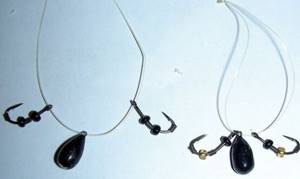
Take a rigid fishing rod, with wire rings and a reel. Definitely a nod.
The tactics for catching perch on a bulldozer are as follows:
- The beam sinks to the bottom
- There should be a sharp rise of 20-25 cm
- Next is the return descent
- Pause for 5-10 seconds, then everything repeats
The point of using a bulldozer is that it raises turbidity, and the bright beads act as bait.
Balda is a bottom tackle, so it is advisable to use it when the perch stays near the bottom.
Fishing with live bait
To catch perch in winter with live bait, use a winter fishing rod of medium hardness, with a fishing line with a diameter of 0.14-0.18 mm. Hooks should be as thin as possible, with a long shank, so that the baitfish remains active for a long time.
The following are used as live bait:
- Bleak
- Verkhovka
- Minnow
- Bystryanka
This kind of fishing has some of its own characteristics:
- You should fish in places where small things may accumulate - near the remains of coastal vegetation, algae
- Monitor the condition of the live bait as often as possible and replace it if necessary.
- The rig involves the use of several weights, the smallest of which should be located near the hook
Unusual lures for perch
There are a number of lures that have shown their effectiveness in catching perch, but are neither traditional jigs, nor spinners, nor balancers. It’s worth talking about them separately
Bottom spinners
Described by the Shcherbakov brothers in sufficient detail, they are used for fishing at depth. The bottom line is that during the game the spoon does not return to the water column, but falls to the bottom. At the same time, a cloud of turbidity rises, and the perch approaches the sound and this cloud. There are many varieties of them, frogs, Honduras, Fantomas, and others. They are made by the fishermen themselves, and they also give them names. Their design is simple, the game is too, and they can be recommended to novice fishermen. The main thing is to let them sit in soda after soldering and sharpen the hooks, otherwise they will rot very quickly in water.
With refill
Many people put a worm on a spoon, and also on a balancer on the bottom hook. This helps to trigger a bite, but greatly disrupts the play of the spinner. There is a spinner and a balancer with a chain and a perch eye. Instead of a hook, a chain is placed on the spoon or balancer, at the bottom of which there is a single hook. They put an eye on it from a perch caught earlier. The tackle is adjusted so that when moving the balancer plows the bottom with this eye on the chain, raising the mud. The chain has very little effect on the game and is more effective than just a worm on the hook of a spoon. Perch, indeed, more reliably holds a bait that has the taste of blood, be it colorless blood of a worm or perch blood.
Fishing with girders
The method is most often used when fishing for pike, but often perch also sits on live bait. The main problem is to get live bait of a suitable size, no more than 7-8 cm in length. It is more difficult to catch fry in winter than in summer. You have to use homemade muzzles from a plastic bottle where you put the bait, but it is also important to know where it stands in the winter. In addition, it lives on a hook for less time than a full-fledged live bait, and it needs to be replaced more often. Therefore, anglers often use a simple worm rather than live bait on the hook for perch. The perch also bites on it, and there is less fuss with it.
Victoria Leshchenko
I've been working hard in the fishing tackle department for the past six years. I can help you assemble almost any gear.
Ask a Question
Often, girders are placed along the shore to understand where the flock has arrived. The fisherman sees that there was a bite, goes there and continues to fish with a spoon or balance beam.
Non-standard baits such as balancers
They use rattlins, cicadas, and amphipods. They have a more pronounced play than a lead balancer. Rattlin also has a sound due to the presence of balls inside. Summer and winter rattlins differ from each other. Amphipod is a special balancer invented by Ukrainian fishermen. It performs complex three-dimensional oscillations during its return, close to a spiral arc. This allows you to collect perch from a greater distance. Cicadas, or bladebaits, are one of the best baits for spinning fishing in the summer. Perch are crazy about them and take better than on spinners, but they are also more volatile. The winter cicada has the shine and play of an ordinary balance beam, but is visible from a long distance. You can try using a summer cicada if there is no special winter one.
Float rod
Perch is rarely caught specifically with it. It can be justified in two cases: either it is a very passive perch, which takes only a stationary bait, or it is very fast fishing, when the fish takes the bait already on the fall, and at this time the angler removes the perch from another fishing rod and casts it. In the first case, the perch bite occurs while catching another fish, and in the second, a spinner or jig is often used so that the fish comes from afar, and then they are caught with a float. Animal bait is often used, delivering a large amount of bloodworms to the bottom, which holds the fish. They are usually caught with two or three fishing rods. At very great depths and in strong currents, this method is in second place after the spinner, since playing with a jig in such conditions is impossible. When fishing, it’s still worth sometimes playing along with bait, since such a bait is more likely to fall into the perch’s field of vision.
Balda
It is a body with hooks on the sides. When oscillating, the hooks hit the body of the bully, creating a ringing sound and attracting perch. As the filming of the Shcherbakov brothers showed, even at a shallow depth the bulldozer does not have such a game, and the hooks simply hang along the body without moving during the game. And in general, we must remember that almost any spinner nails harder at depth. However, when fishing in shallow water, the bullhead shows good results and does not require any special skill when playing it.
You can ask your question to our author:
Perch fishing in December
Perch fishing this month is particularly stable. This is a period when the first ice is just appearing on some reservoirs, which in itself implies high fish activity. On other bodies of water, the ice has been holding for a long time, the heat has passed, but there is still every chance of a good catch.
There is an opinion among anglers that after the period of first ice, the perch bite declines, but this is not the case. The fish simply take their usual wintering places, where they also continue to feed.
Therefore, for the most part, attention should be paid not to searching throughout the entire reservoir, but to targeted fishing of promising places.
Perch: description

This fish belongs to the perch family (Percidae) of the order Perciformes. The breed is numerous and quite widespread. There are a total of about 150 species. But in our reservoirs there are only 2.
Sometimes the perch is called the humpback, due to its slightly convex back. Small coastal perches eat insect larvae and zooplankton. A deep black-backed predator, it eats mainly small fish and its smaller brothers.
Appearance
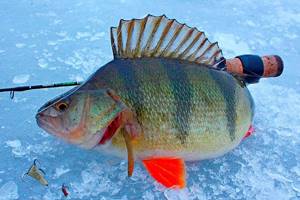
Perch has a beautiful greenish color of various shades. With transverse dark stripes throughout the body. The body is short, laterally flattened, covered with small ctenoid scales. Small perches are lighter in color, while mature predators are darker.
The color is influenced by the color of the bottom of the reservoir, water quality, and time of year. Its gill covers are iridescent, with a unique pearlescent iridescence. The fins are all red and elegant. On the humpbacked back the fins are higher, with spiny, spiked rays.
The eyes are slightly convex, orange, surrounded on all sides by a golden border. The teeth are bristle-like, helping to eat and hold prey. Freshwater perches are usually small in size, no more than 250 grams, about 45-55 cm long. They live on average up to 10-12 years.
Habitat
- They live in many bodies of water in their range: ponds, reservoirs, lakes, alpine lakes, rivers.
- They are found in coastal areas of the seas and brackish lakes.
- The maximum habitat depth is 30-50 meters, but there is evidence that it is also found in deeper water places.
- They spend most of their lives closer to the bottom, near various obstacles, such as flooded trees and snags.
Spawning
Spawning occurs once a year. This time falls in March-April. Keep an eye on the birch trees; when their leaves bloom, it means spawning has begun. By this time, the water in the reservoirs has time to warm up to 7-8° C.
The female lays fertilized eggs on various nearby vegetation such as reeds, duckweed, and algae. Externally, caviar looks like gelatinous ribbons, reaching up to 1 meter.
Perch behavior
The behavior of a predator can change significantly throughout the day, much depends on the weather and time of year. In the spring, after spawning, it most often prefers to be in shallow bays, where it recently spawned and eats there. Schools of white fish also come into such bays to spawn.
And this is the ideal time for our perch to profit and recover a little after a hungry winter and spawning. And only in May it gathers in small flocks and leaves the shallow waters. In the summer, it prefers to set up ambushes in quiet creeks, overgrown with dense coastal vegetation, in barrels, and water lilies.
But their most favorite places are the snagged bottoms of rivers and areas of the relief bottom adjacent to the riffles. In the summer heat, it eats less often and takes refuge more in coastal shady zones: bridge spans and supports, cliffs, shade of trees.
Large specimens hide in places hard to reach for people:
- pits, whirlpools;
- potholes with uneven bottom relief.
Perch usually comes out to feed in the evening after dark or at dawn. In large bodies of water it hides in stones, on elevated bottoms, in coastal thickets, on islands, and shallows. In the fall, it gathers in flocks and gradually moves into the depths of the reservoir.
Because in the deep layers the water is warmest. With the first frosts, activity increases; it does not stand in one place. Often schools of perches can be seen moving freely throughout the water area in search of food.
In winter, at shallow depths, a rapid process of decomposition of underwater plants occurs, significantly reducing the oxygen content in the water. All vital processes of aquatic life slow down significantly. The fish moves reluctantly and eats little.
Let's celebrate! But by spring it gradually comes to life and begins to actively chase small prey and eat greedily. It approaches the mouths of melted rivers and streams that bring oxygen. Gradually leaves the wintering area in search of food and spawning grounds.
